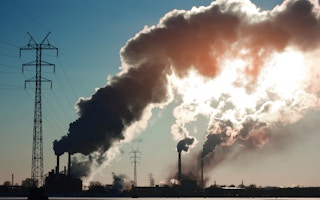Launching the 2020 UN climate summit (COP26) this week, British Prime Minister Boris Johnson called for international action to achieve global net zero emissions by 2050. A coalition of British air travel companies, Sustainable Aviation, swiftly announced plans to go net-zero carbon by mid-century.
Real action to drastically cut greenhouse gas emissions is crucial if we’re to meet the goals of the Paris Agreement to limit global warming to 1.5°C and avert catastrophic climate change. This means polluting economies must undergo a total transformation within ten years.
Companies stepping up to take climate action is a positive first move, but it’s important to be mindful of the approach being taken. “Net zero emissions” may sound like an ambitious goal, but the term can hide a multitude of loopholes that can delay real climate action and drive devastating land grabs and hunger in the Global South.
While the intent may seem positive, there is a deeply concerning reason the UK aviation industry can pledge a net zero target while still planning to expand Heathrow and increase overall flight numbers.
“Net zero” refers to achieving an overall balance between emissions produced and emissions taken out of the atmosphere.
But instead of actually cutting emissions, fossil fuel companies and governments, joined by increasing numbers of multinational corporations, can use the term “net zero emissions” to evade their responsibilities and continue polluting, business as usual.
By relying on trees and unproven technologies to suck carbon dioxide (CO2) from the air to compensate, they can continue to pump out greenhouse gases — for decades.
Distant 2050 goals allow governments to delay real climate action for another 30 years.
It will take political bravery to really respond to the climate emergency, and ensure we can meet the goal of limiting planetary warming to 1.5°C.
But this is not the only problem with net zero targets.
“
By relying on trees and unproven technologies to suck carbon dioxide (CO2) from the air to compensate, they can continue to pump out greenhouse gases — for decades.
Most net zero goals assume that an untested technology called Bioenergy combined with Carbon Capture and Storage (BECCS) will be implemented and scaled up so as to remove CO2 from the atmosphere.
The concept is based on burning biomass from tree plantations in power plants, then using technology to capture the resulting CO2 emissions and store carbon, most likely underground.
This amounts to crossing our fingers that as-yet-unproven technologies will somehow come good and can solve the climate problem without the need for any real system change.
But there are major technical challenges with BECCS. It is incredibly risky for governments to put the fate of the planet in the hands of a technology that might never work.
And even if BECCS does end up working effectively on a large scale, it would require vast areas of land for tree plantations, fuelling huge land grabs and hunger in Africa, Asia and Latin America.
Some estimates suggest that using BECCS to stabilise global temperatures at under 2°C of warming, would require nearly 1 billion hectares of land. To put this into context, global crop production currently covers 1.5 billion hectares.
If implemented on a large enough scale to address the climate crisis, removing CO2 from the atmosphere with BECCS would end up harming poor and marginalised communities in the Global South — those who have done the least to cause the climate crisis but who are already suffering the most.
‘Real zero’ needed
ActionAid’s report Caught in the Net raised real concerns about net zero targets being used to delay climate action back in 2015.
If the term “net zero” had been defined early on to mean rapid greenhouse gas reduction to near zero, with the remainder of emissions balanced out through restoration of biodiverse ecosystems, it might have served as a useful goal to drive real transformation.
But now the term is so vague that companies and politicians can use it to disguise their lack of real action while we head towards a disastrous 3-5°C warmer world.
Already millions of people across southern and eastern Africa are facing a hunger crisis that has been exacerbated by climate change, with the worst drought the region has seen in 35 years, flooding, cyclones and a locust invasion — in which poor women and girls are among those most affected. Communities in Australia continue to be devasted by unprecedented bushfires.
As climate activist Greta Thunberg recently pointed out at the World Economic Forum in Davos, we need “real zero”, not “net zero” emissions.
The COP26 Glasgow climate talks in November this year are a crucial opportunity for leaders to convert the energy and outrage of ordinary citizens, led by young people, into bold government responses that match the scale of the climate crisis, and support those most affected.
For this to happen, we have to put real transformation on the agenda, and stop disguising inaction with vague “net zero” targets.
Teresa Anderson is climate policy coordinator at ActionAid International.
This story was published with permission from Thomson Reuters Foundation, the charitable arm of Thomson Reuters that covers humanitarian news, women’s and LGBT+ rights, human trafficking, property rights, and climate change. Visit http://news.trust.org.


















